Châteauneuf-du-Pape is a small medieval village on the side of a hill, guarded by the ruins of an ancient chateau towering above. From the chateau hill you have an outstanding view in all directions, mostly of vineyards and of the Rhône River 1.9 miles to the east. The village is between Avignon (7.5 miles to the south) and Orange (6.6 miles to the north).
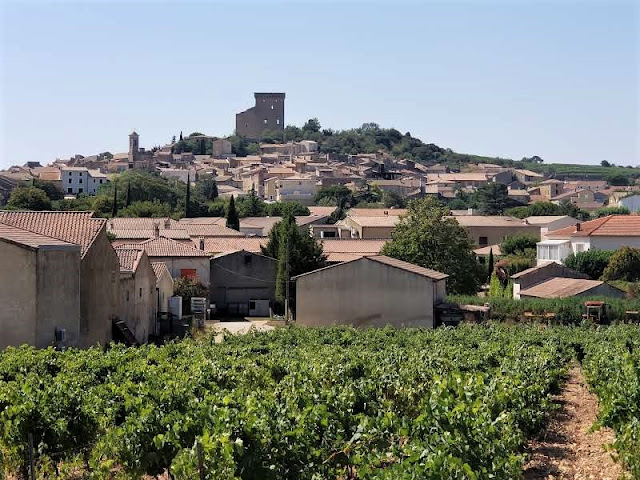 |
| Châteauneuf-du-Pape |
As its name suggests, Châteauneuf-du-Pape is closely linked to several Popes. As early as 1157, faithful to Roman customs, Bishop Geoffroy of Avignon planted and cultivated a vineyard in his Châteauneuf territory. In 1308, Clement V also planted vines, thereby becoming one of the first winemakers in Châteauneuf.
Pope Jean XXII, the second of the popes to reside in Avignon, had a particular appreciation for wine from this area, and ordered the castle seen below to be built in 1317 as a summer residence, and bestowed upon the wine, the title of “Vin du Pape” (Papal Wine), the name by which it was known before it became “Châteauneuf-du-Pape”.
The back side of the tower of the Pope's castle is shown in the photo below, only ruins remain. The castle was sacked by Routiers (mercenaries who terrorized the French countryside during the 100 year war) when Jean XXII died and largely destroyed for the final time by the retreating Germans in 1944.
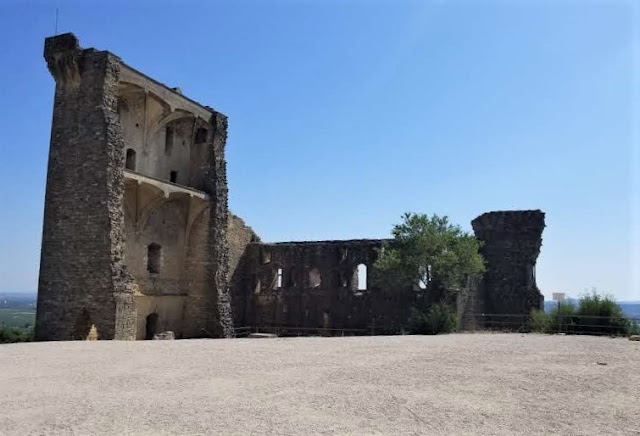 |
| Pope's Castle Châteauneuf-du-Pape |
There are several cafés with outdoor terraces around the center of the village. Although this is a tourist town, there are not many tourist shops as the business of Châteauneuf-du-Pape is selling wine.
The village streets are narrow, curving around the hillside or climbing up and down between the houses up to the castle. The buildings are old, but everything has been thoroughly restored.
The chateau ruins at the top of the village are accessed by walking up Rue Joseph Ducos past the front of the Town Hall to the church at Rue des Papes. Just to the left of the church, steps lead up the wide, stone step-street to the chateau.
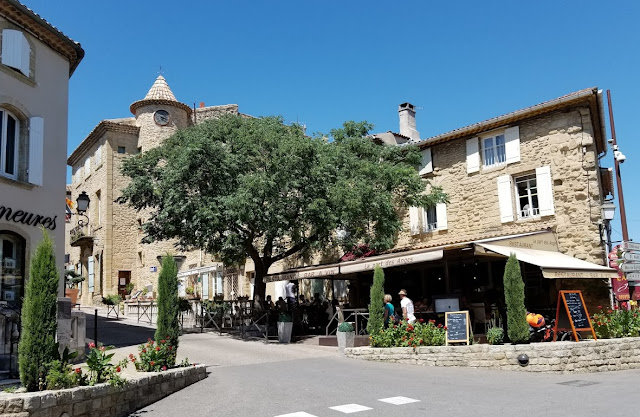 |
| Center of Châteauneuf-du-Pape Village |
As I indicated above, we come often to Châteauneuf-du-Pape, for the wines. The sign below which you see alongside the roads that cross into the Châteauneuf-du-Pape appellation reads "Here begin the celebrated vineyards of Châteauneuf-du-Pape."
Châteauneuf-du-Pape AOC wines are made from grapes grown in the commune of Châteauneuf-du-Pape and portions of the four neighboring municipalities (Bédarrides, Courthézon, Orange, and Sorgues) in the Vaucluse.
There are 13 grape varieties permitted in Châteauneuf wines, although it's rare that most are used in one blend. Grenache is dominant in the reds, supported by Syrah, Mourvèdre, Cinsault, Counoise, Muscardin, Vaccarèse and Terret. White wines are a blend of Clairette, Roussanne, Bourboulenc, Picpoul and Picardin.
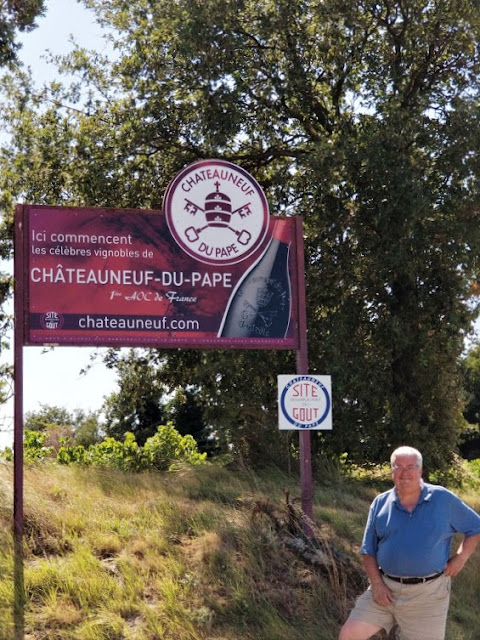 |
| Châteauneuf-du-Pape AOC Boundary |
Our favorite Châteauneuf-du-Pape winery is located just outside the village on the Route de Courthézon. We first became acquainted with Domaine de la Charbonnière and its wines when we tasted wines for the initial wine list for our Bistro Des Copains in Occidental, California and have been fans ever since.
The domaine is owned by the Maret family, daughters Véronique and Caroline and parents Michel and Mireille, and have been making wine since 1912 when Michel Maret's grandfather Eugene bought the domaine as a gift for his wife who was the daughter of a local winegrower. Michel took over in 1978 and started bottling wine-most of it sold out the winery door.
He was the one who named the estate Domaine de la Charbonnière from the name used for the area around the domaine. The name means "the area of charcoal burning".
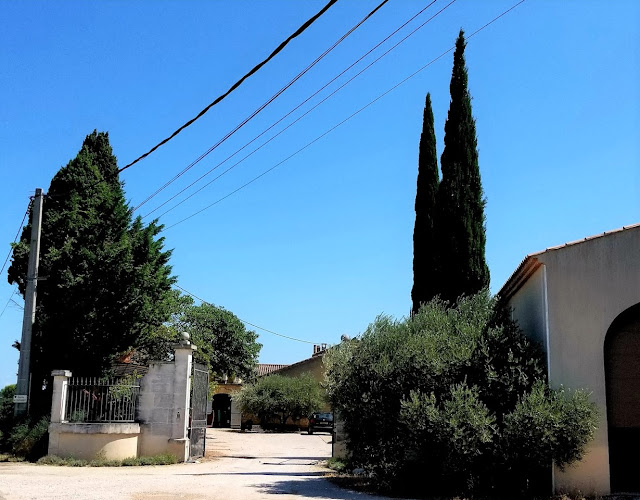 |
| Domaine de la Charbonnière |
Véronique took over winemaking responsibilities from Michel in 2012 after starting at the domaine alongside her father, in 2009. Michel, although now retired, still drives the tractor and helps her in the cellar. Véronique and Caroline are the fourth generation of Maret's to oversee the domaine. Mother Mireille continues to manage the vineyard team.
One of the most important changes Véronique made since taking over in 2012 was the move to organic viticulture.
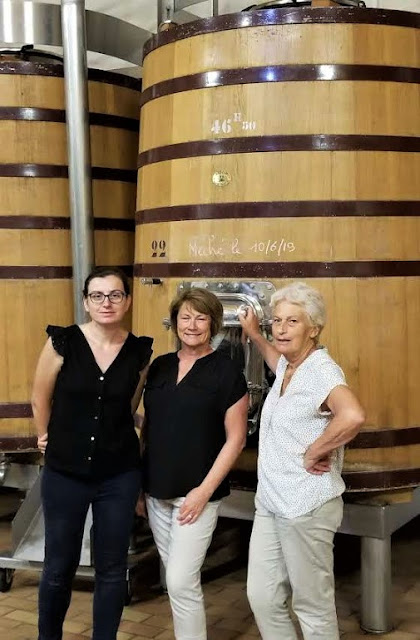 |
| From left, Caroline Maret, Shirley, and Mireille Maret |
The wines from Domaine de la Charbonnière have not suffered at all from the change in winemaking responsibilities, in fact they seem to be getting better with each harvest, if that is even possible. Take a look at the tasting points in the November 15, 2019 issue of "Wine Spectator Magazine".
| Wine Spectator Magazine | ||||||
| November 15, 2019 | ||||||
| Domaine de la Charbonnière | Cuvee | Vintage | WS Points | |||
| Châteauneuf-du-Pape | Les Hautes Brusquières | 2016 | 96 | |||
| Châteauneuf-du-Pape | Vielle Vignes | 2016 | 95 | |||
| Châteauneuf-du-Pape | Red | 2016 | 94 | |||
| Châteauneuf-du-Pape | Mourre des Perdrix | 2016 | 94 | |||
| Châteauneuf-du-Pape | White | 2017 | 93 |
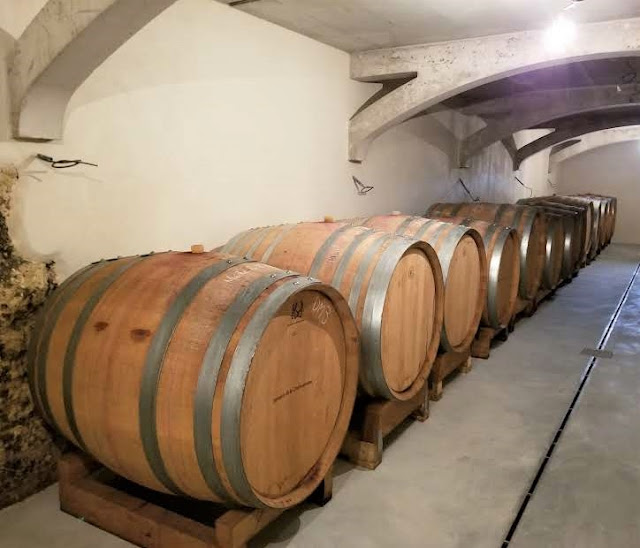 |
| New barrel room at Domaine de la Charbonnière |
To accommodate the growing demand for their excellent wines, they have recently finished an expansion of their barrel room.
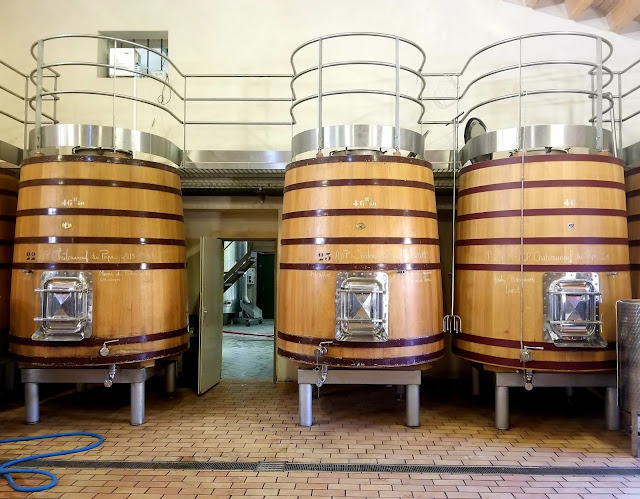 |
| Domaine de la Charbonnière Wood Tanks |
The majority of the grapes for wine made by Domaine de la Charbonnière comes from parcels in Châteauneuf-du-Pape. They also own and make wine from parcels they own in the Vacqueyras AOC and in Côtes du Rhône, just outside the Châteauneuf-du-Pape AOC boundary. Their two different bottlings of 2016 Vacqueyras both earned 90+ points from Wine Spectator Magazine.
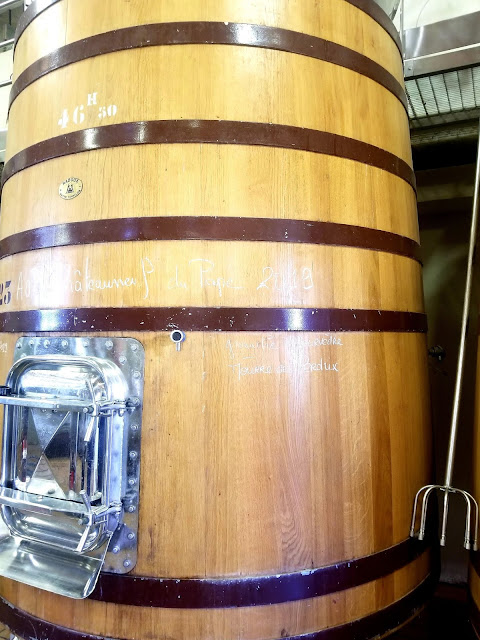 |
| Domaine de la Charbonnière 2019 Châteauneuf-du-Pape Cuvée Mourre des Perdrix in Wood Tank |
 |
| Steel Tanks Holding 2019 Grapes |
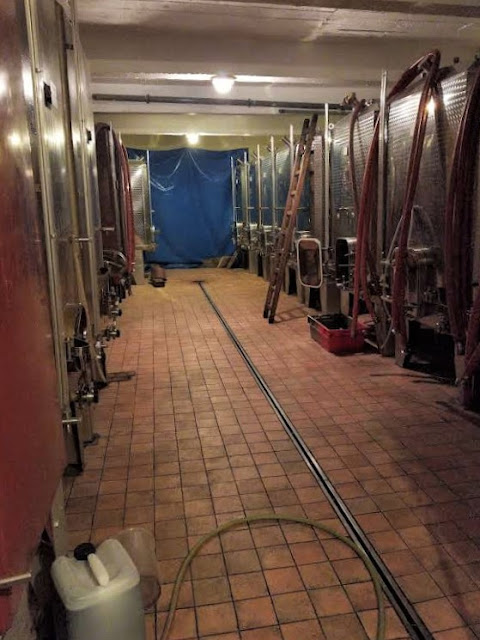 |
| Inox (stainless steel) tanks at Domaine de la Charbonnière |
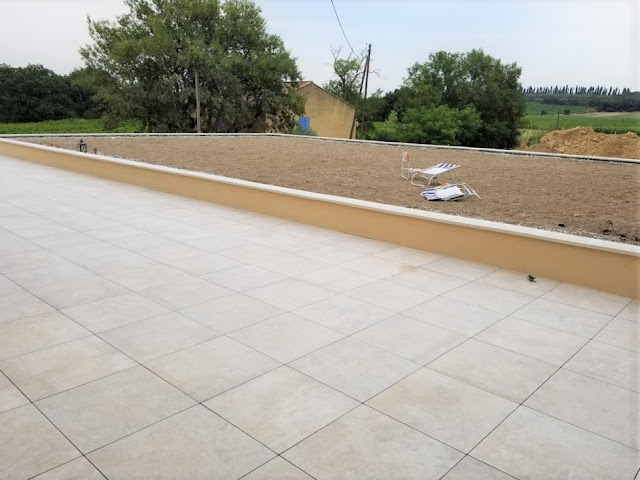 |
| Terrace over the new barrel rooms at Domaine de la Charbonnière |
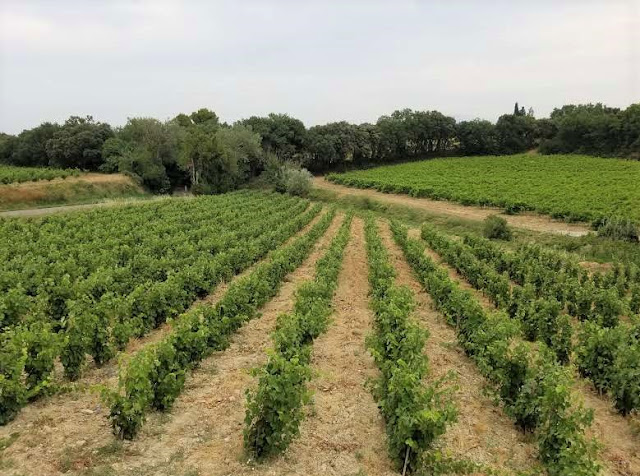 |
| Domaine de la Charbonnière estate vineyards |
There are several distinct terroirs in Châteauneuf-du-Pape. Clay soils and those with galets-large round pebbles that store heat, make full-bodied, structured reds; sandy soils produce lighter, more elegant wines. The whites, which are full-bodied and aromatic, with yellow fruits and floral notes, favor the limestone soils.
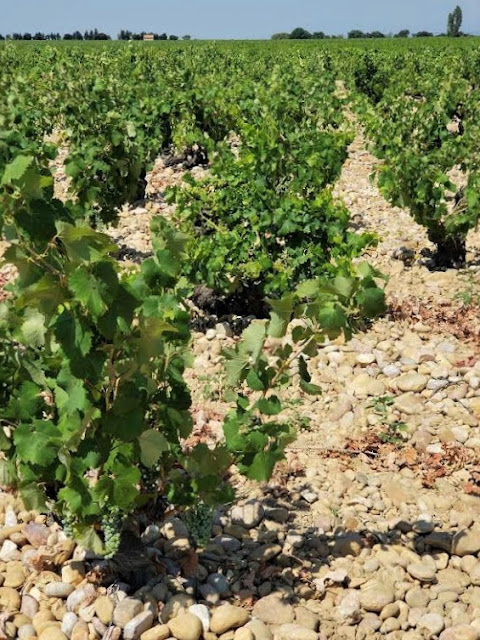 |
| One of the Châteauneuf-du-Pape vineyards with layer of stones called galets (pebbles) |
The best thing about Domaine de la Charbonnière is the Maret Family, they are all charming, funny, and always have a smile to greet you, even during the middle of vendange (grape harvest). After many tastings at Domaine de la Charbonnière over the years, I can say we are friends.
We were very happy we could meet Véronique and Caroline when they were in Sonoma and Napa County a few weeks back, visiting customers with their new California importer, Grape Expectations, and take them to dinner in Sonoma.
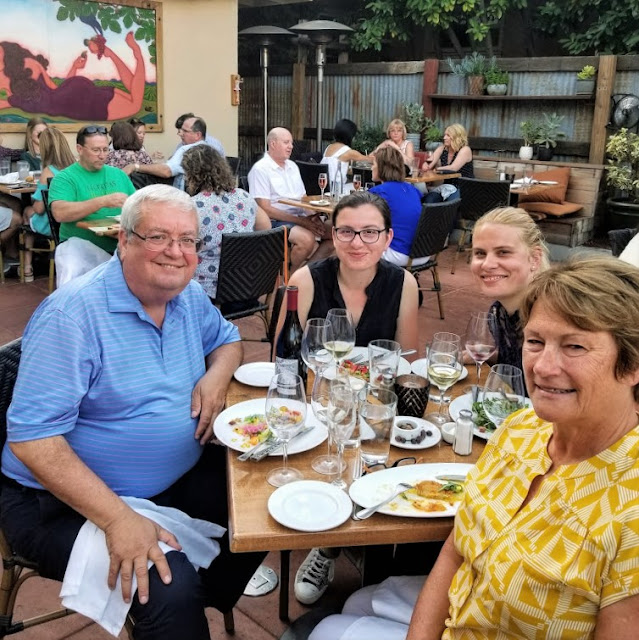 |
| Girl and the Fig in Sonoma California with Caroline and Véronique Maret |
If you are in the Vaucluse region of France, and tasting wine is part of your trip, it is well worthwhile to visit and taste at Domaine de la Charbonnière. If you are in shops that sell special wines or in a nice restaurant, French or otherwise in the US, Canada, or UK, make sure you check to see if they have a bottle on the list from Domaine de la Charbonnière. Trust me, you will be very happy you did.
Domaine de la Charbonnière
Route de Courthézon
84230 Châteauneuf-du-Pape
Tel: +33 (0)4 90 83 74 59
contact@domainedelacharbonniere.com
If you are planning for your next vacation and it might include a visit to the south of France, check out our website about our home in Sablet which we rent by the week or for longer periods of time. www.sablethouse.com


